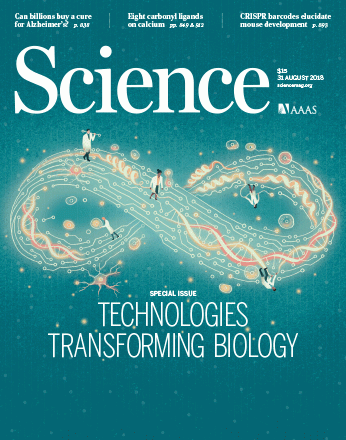(원문: 여기를 클릭하세요~)
과학자가 세운 가설은 실험이나 관측을 통해 검증되기 전엔 과학적 지식으로 인정받지 못한다. 지난 2016년 3월, 레이저 간섭계 중력파 관측소(LIGO)의 장비를 통해 알버트 아인슈타인이 100여 년전 예측했던 중력파가 모습을 드러냈다. 중력파 관측기술이 더 늦게 개발됐다면 아인슈타인의 생각은 더 오랫동안 가설로 머물러야 했을 것이다.
흔히 빅뱅이론으로 불리는 우주 탄생에 순간에 대한 내용도 아직 명확히 검증되지 않았다. 때문에 이론이라 말하면 안 된다는 주장도 있다. 빅뱅이론의 실체를 검증할 기술이 마련되지 않은 것이다. 이처럼 기술적 혁신은 과학의 지식의 확장과 발전에 있어 지대한 영향을 미친다.

Science 제공
생물학 분야도 예외는 아니다. 국제학술지 사이언스는 31일자에 ‘기술이 변화시키는 생물학’이라는 제목과 함께 인간이 가진 상상력과 기술들이 어우러지는 뫼비우스띠를 표지 그림으로 실었다. 사이언스에서 과학과 의학을 담당하는 선임 칼럼니스트인 스티브 마오와 발다 빈손이 함께 작성한 ‘강력한 커플, 과학과 기술’이란 글도 포함됐다.
스티브 마오는 글에서 “과학 분야 중 생물학은 기술의 영향을 특히 크게 받는다”고 말했다. 현미경을 통해 세포와 분자를 볼 수 있게 되면서, 세포생물학이나 분자생물학과 같은 학문이 생겨났다. 또 단일세포를 보게 되고 나서야 면역학이나 발달생물학 등이 발전할 수 있었다.
19세기 전자기학이나 20세기 양자역학처럼 물리학 분야에선 관측기술이나 측정 기술이 미비했던 때에도 새로운 학문의 패러다임이 생기곤 했다. 반면 생물학은 기술이 먼저 발달한 후에야 획기적인 학문이 탄생할 수 있었다는 것이다.
최근에는 크리스퍼-캐스9 단백질 복합체를 이용한 유전자 편집 기술이나 생체 내에서 살아있는 세포를 보는 초저온 전자현미경(Cryo–EM)기술이 각광받는 중이다. Cryo–EM은 수용액에 담긴 생화학 분자를 영하 200도 이하의 초저온 상태로 급냉각시켜 정밀 관찰하는 방식의 전자현미경이다. 실제 동물의 체내 환경에서 자연스럽게 움직이는 단백질은 물론 바이러스 등의 생체 분자의 ‘스냅샷’을 찍을 수 있다. 이를 통해 한차원 높은 생물학의 발전이 찾아오리란 전망도 나온다.
한편 이번호에는 과학칼럼니스트인 이판 청이 쓴 ‘단일 입자 움직임보는 초저온 전자현미경’, 가빈 크노트의 ‘유전자공학의 미래를 안내하는 크리스퍼-캐스 단백질’ 등의 글들이 포함됐다.
http://science.sciencemag.org/content/361/6405/864?rss=1
Science 31 Aug 2018:
Vol. 361, Issue 6405, pp. 864-865
DOI: 10.1126/science.361.6405.864
Every revolution in technology is followed by an explosion of new scientific knowledge. Biology is no exception. Van Leeuwenhoek’s microscope jump-started microbiology, polymerase chain reaction revolutionized molecular biology (see Editorial in this issue), and single-cell imaging and sequencing approaches remarkably advanced immunology, cancer research, developmental biology, and beyond.
Recent years have witnessed disruptive innovations in biotechnology. Researchers have never been equipped with more powerful tools to probe biology. Breakthroughs in electron microscopy allow biomolecular complexes to be visualized with high resolution, offering insight into the workings of these molecular machines. Ingenious methods to break the diffraction limit in microscopy enable single molecules to be observed and tracked in single cells. Not only do we see cells in ever-greater detail, but with CRISPR-mediated gene editing techniques, biologists can precisely and easily manipulate cellular genomes of diverse organisms. As we gain understanding of biological networks, tools including those based on CRISPR give us the ability to record biological events, to detect and treat disease, and to engineer plants with new traits and greater productivity.
When biologists encounter problems that cannot be solved by currently available technologies, shared creativity between researchers drives the development of better and smarter tools. New technologies, in turn, push the frontier of biology. This synergy has been moving our society and humanity forward, and the advent of artificial intelligence is likely to speed up this cycle of discovery.